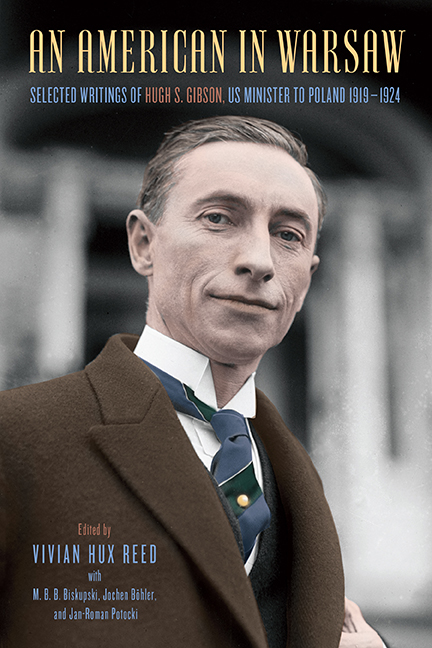Book contents
- Frontmatter
- Dedication
- Contents
- List of Illustrations
- Foreword
- A Few Things about My Father
- Acknowledgments
- Chronology
- Introduction
- 1 A New Observer in a New Poland: 1919
- 2 A Wild Ride: 1920
- 3 Aftermath and Rebuilding: 1921
- 4 A Wedding and a Funeral: 1922
- 5 Stabilization: 1923
- 6 Changes in the Wind: 1924
- Epilogue
- List of Publications by Hugh S. Gibson
- Rochester Studies in East and Central Europe
- Selected Bibliography
- Index
Epilogue
Published online by Cambridge University Press: 09 June 2021
- Frontmatter
- Dedication
- Contents
- List of Illustrations
- Foreword
- A Few Things about My Father
- Acknowledgments
- Chronology
- Introduction
- 1 A New Observer in a New Poland: 1919
- 2 A Wild Ride: 1920
- 3 Aftermath and Rebuilding: 1921
- 4 A Wedding and a Funeral: 1922
- 5 Stabilization: 1923
- 6 Changes in the Wind: 1924
- Epilogue
- List of Publications by Hugh S. Gibson
- Rochester Studies in East and Central Europe
- Selected Bibliography
- Index
Summary
On Sunday morning, May 5, 1924, the Gibsons left Warsaw together for the last time. The Second Polish Republic they left behind had changed and solidified considerably since 1919. Nevertheless, it remained a “house divided.” Although characterized by a largely heterogeneous population (Poles, 70 percent; Ukrainians, 14 percent; Jews, 9 percent; Belarussians, 3 percent; and Germans, 3 percent), Poland was also divided along a multitude of political lines and faced innumerable economic difficulties. Both its allies and its foes were similarly divided, as the whole world shuddered between longed-for peace and new threats of violence.
Gibson settled quickly into his new role in Bern as minister to Switzerland. During Gibson's three-year tenure there (1924–27), Piłsudski, back in Warsaw, staged a coup d’etat in 1926. Although he never assumed the official title of head of state, he did lead the country de facto until his death in 1935. Between 1935 and 1938 Poland continued to orient itself toward Germany as the perennial Russian threat strengthened under the solidifying Soviet regime. Increasing demands from the newly empowered Nazi regime in Germany removed any illusion of an alliance with Poland's western neighbor against the eastern one. As an aggressive Germany annexed Austria and swallowed up the Sudetenland, the Poles became increasingly wary that they would be next. Despite considerable anxiety over Soviet intentions, Poland refused to join Germany and her allies in the so-called Anti-Comintern Pact. On August 23, 1939, the infamous Molotov-Ribbentrop Pact ensured nonaggression between Germany and the Soviet Union—two ideological archenemies as opposed to each other as they were antagonistic to Poland. Once again Poland faced dire danger from both sides.
The German invasion from the west on September 1, swiftly followed by the Soviet invasion from the east on September 17, put an end to the Poland Gibson knew and loved. Poland was severed once more, and Poles suffered yet again. The tragic circumstances of World War II, with its successive waves of German and Soviet Russian incursions across Poland, is well documented. What is unique to Gibson's involvement is his sustained humanitarian activity and dedication to the Poles.
- Type
- Chapter
- Information
- An American in WarsawSelected Writings of Hugh S. Gibson, US Minister to Poland, 1919–1924, pp. 527 - 530Publisher: Boydell & BrewerPrint publication year: 2018



